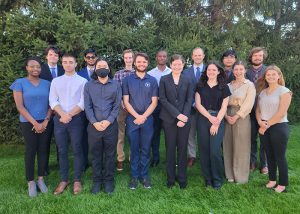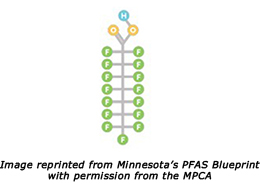December 2022
Inside the Newsletter:
Wastewater | Apply for Intern | PFAS | Food Processing
Outstanding Wastewater Nitrogen Treatment
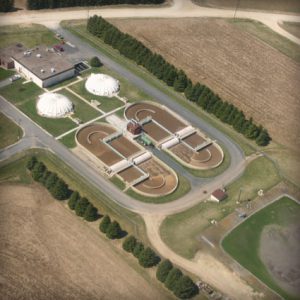 In 2021 the Whitewater River Regional Wastewater Treatment Plant had an average effluent total nitrogen level ranging from 29 to 74 mg/L. In 2022, the facility received a new nitrogen permit limit of 10 mg/L and knew they needed to try something new to meet these limits. The plant manager explored strategies to achieve biological nutrient removal with the oxidation ditches in partnership with MnTAP. The project team used a wastewater simulation program, the Activated Sludge Simulation Model (ASIM) to explore possible operational changes that could achieve the needed level of nitrogen removal. The team discovered that cycling aeration on and off with a timer in the main oxidation ditch while maintaining solids suspension using a smaller pump would result in much better treatment for nitrogen and phosphorus.
In 2021 the Whitewater River Regional Wastewater Treatment Plant had an average effluent total nitrogen level ranging from 29 to 74 mg/L. In 2022, the facility received a new nitrogen permit limit of 10 mg/L and knew they needed to try something new to meet these limits. The plant manager explored strategies to achieve biological nutrient removal with the oxidation ditches in partnership with MnTAP. The project team used a wastewater simulation program, the Activated Sludge Simulation Model (ASIM) to explore possible operational changes that could achieve the needed level of nitrogen removal. The team discovered that cycling aeration on and off with a timer in the main oxidation ditch while maintaining solids suspension using a smaller pump would result in much better treatment for nitrogen and phosphorus.
During the warmer summer months a cycle time of 90 minutes on and 90 minutes off achieved excellent nitrogen removal. As the weather got cooler in the fall, cycle times were modified to 90 minutes on, 115 minutes off to provide additional time for denitrification. Work continues to optimize aeration cycling ratios for winter operations with time off likely to increase to compensate for slowed biological processes in cold weather.
The plant achieved the best nitrogen levels it has ever seen decreasing from a 2021 average total nitrogen of 48.9 mg/L to 3.9 mg/L. This is a decrease of 92% in the total nitrogen effluent load and enough to easily meet the new nitrogen permit limit!
| 2021 Average Total Nitrogen | 48.9 mg/L | 79,500 lb/yr |
| New Average Total Nitrogen | 3.9 mg/L | 6,300 lb/yr |
| Reduction | 45 mg/L | 73,200 lb/yr |
Energy savings is a nice co-benefit of the project. The smaller pump used to maintain solids suspension uses less energy than the aeration system, estimated to save the facility 160,000 kWh and $11,600 per year.
For More Information, Contact:
Jon Vanyo – Senior Engineer
612-624-4683 or 800 – 247 – 0015
jvanyo@umn.edu
Apply for Your 2023 MnTAP Intern!
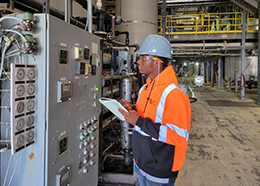 Just in case you may have missed it, MnTAP Solutions was published in November and highlights the successful projects from the 2022 MnTAP intern program. Amazing results! So, before you do anything else today, click this link to Apply Now for a 2023 MnTAP Intern at YOUR facility. Even if you are not certain about the project you would like to do, MnTAP can work with you to develop a great opportunity for your site. The important part is to start the process NOW!
Just in case you may have missed it, MnTAP Solutions was published in November and highlights the successful projects from the 2022 MnTAP intern program. Amazing results! So, before you do anything else today, click this link to Apply Now for a 2023 MnTAP Intern at YOUR facility. Even if you are not certain about the project you would like to do, MnTAP can work with you to develop a great opportunity for your site. The important part is to start the process NOW!
The MnTAP intern program pairs manufacturing, food processing, hospitality and other facilities in Minnesota with a college student who researches and recommends water conservation, energy efficiency and pollution prevention solutions. MnTAP interns have helped identify opportunities that save participating companies millions of dollars annually.
If your company could use another set of eyes to achieve similar results, now is the time to start thinking about developing a project for the summer of 2023. We anticipate supporting 15-18 projects that could focus on water conservation, energy efficiency, paint efficiency, solid waste, and pollution prevention.
Applications are currently being accepted and will be reviewed upon receipt. Companies will be contacted by MnTAP technical staff within two weeks for additional project development and scoping. Although applications are accepted through January 2023, companies are encouraged to apply by the end of 2022 to provide enough time to scope a well-defined project at their facilities.
For more information about the intern program or the application process, visit the MnTAP Intern Program webpages for Businesses. Use the Apply link to the Intern Company Application.
For More Information, Contact:
Matt Domski – Intern Program Manager
612-624-5119
mdomski@umn.edu
PFAS Pollution Prevention Best Practices
MnTAP is launching a new project that will focus on defining pollution prevention (P2) opportunities for PFAS within the Metal Manufacturing and Fabrication, Food and Beverage Manufacturing and Processing, and Chemical Manufacturing, Processing and Formulation industries to prevent PFAS pollution and limit PFAS exposure from food.
What is PFAS and where is it used?
Per- and polyfluoroalkyl substances (PFAS) are a large family of manmade chemicals that contain at least one fully fluorinated carbon in a chain. They are used in multiple applications across many industries to provide desirable performance attributes in products and processes. Performance improvements include repelling water and grease, reducing friction, reducing fire risk, and acting as a nonreactive or heat resistant layer between materials. PFAS have high performance characteristics which makes them exceptionally effective in commercial and industrial applications as they do not easily degrade.
PFAS materials sound useful, what is the challenge?
The incredible stability of PFAS that provides these great performance characteristics is also their biggest challenge. The high durability of these materials also means they do not readily breakdown over time under typical environmental conditions. This persistence has led to the nickname “forever chemicals”. Due to this environmental persistence and increasing usage in an expanding array of applications, PFAS has accumulated in our water and soil over time. Some PFAS bioaccumulate in living organisms, and at certain levels they are toxic, causing adverse health effects in humans, fish, and wildlife.
What is MnTAP planning to do?
MnTAP is launching a new project that will focus on defining pollution prevention (P2) opportunities for PFAS within the Metal Manufacturing and Fabrication, Food and Beverage Manufacturing and Processing, and Chemical Manufacturing, Processing and Formulation industries to prevent PFAS pollution and limit PFAS exposure from food.
The focus of the project will be to identify and share source reduction strategies and support businesses through technical assistance as they seek to reduce their emissions of PFAS through pollution prevention. In addition, this project will seek to provide sector specific assessment guides to assist industry leaders in proactively evaluating their operations for possible PFAS uses and opportunities for reduction or replacement.
How do I contact MnTAP for more information?
Contact:
Kelsey Klucas – Engineer
612-624-4619
kluc0035@umn.edu
Where can I learn more about PFAS and plans for managing it in Minnesota?
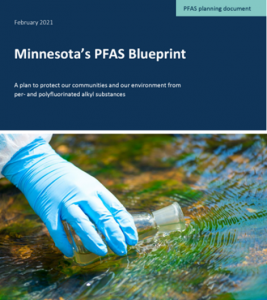 PFAS has been detected in air, water, and soil across Minnesota. Minnesota state agencies have developed a strategy for addressing PFAS that focuses on preventing PFAS pollution to the extent possible, managing PFAS pollution in cases where prevention is not possible, and cleaning up PFAS contaminated areas. The Minnesota PFAS Blueprint outlines strategies across 10 interrelated priority areas ranging from measuring PFAS, defining the risks, preventing further pollution, limiting exposure, remediation and managing PFAS waste. A summary and the full report are available.
PFAS has been detected in air, water, and soil across Minnesota. Minnesota state agencies have developed a strategy for addressing PFAS that focuses on preventing PFAS pollution to the extent possible, managing PFAS pollution in cases where prevention is not possible, and cleaning up PFAS contaminated areas. The Minnesota PFAS Blueprint outlines strategies across 10 interrelated priority areas ranging from measuring PFAS, defining the risks, preventing further pollution, limiting exposure, remediation and managing PFAS waste. A summary and the full report are available.
Food Processing Pollution Prevention
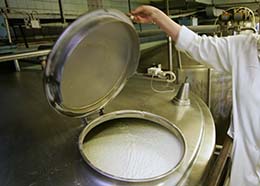 The food processing industry is an essential component of Minnesota’s economy, accounting for almost 25% of the total shipments by Minnesota manufacturers in 2020. Within the food and beverage industry, dairy manufacturing, animal and meat processing, and beverage manufacturing comprise almost 600 Minnesota businesses. Since 2018, MnTAP has helped prevent pollution in numerous food industry facilities, including:
The food processing industry is an essential component of Minnesota’s economy, accounting for almost 25% of the total shipments by Minnesota manufacturers in 2020. Within the food and beverage industry, dairy manufacturing, animal and meat processing, and beverage manufacturing comprise almost 600 Minnesota businesses. Since 2018, MnTAP has helped prevent pollution in numerous food industry facilities, including:
- Kemps Dairy Products in Farmington: Annual savings of 13,300,000 gallons of water and $110,000
- Rochester Meat in Rochester: Reduced BOD load by decreasing meat going to sewer by 15,000 lb/yr, saved 350,000 kWh electric energy and reduced operating cost $50,000 per year.
- Lamb Weston in Park Rapids: Annual savings of 5,000 pounds of chemical, 42,000 pounds of product, 9,900,000 gallons of water, and $137,000
- Living Green Farms in Faribault: Annual savings of 570,000 gallons of water, 140,000 kWh, and $16,500
MnTAP, in partnership with the MPCA’s Resource Management and Assistance Division, has received a grant from the US EPA to expand our pollution prevention work to food and beverage manufacturers throughout Minnesota. All Minnesota food and beverage producers, no matter how big or small, are eligible for MnTAP’s services under this grant. If your food company has one or more Minnesota facilities that would benefit from pollution prevention, then this work is for you!
This grant covers MnTAP’s support to Minnesota organizations in all of the following ways:
- On-site technical assistance by a MnTAP specialist in water conservation, wastewater and chemical loading reduction, energy efficiency, and waste minimization
- On-site summer internships by college students, led and facilitated by MnTAP
- Case studies, technical publications, and industry resources available on the MnTAP website
For more information on MnTAP’s capabilities at food and beverage manufacturers contact:
Kevin Philpy – Senior Engineer
612-624-0206
philp029@umn.edu
